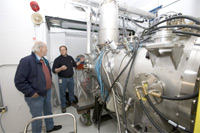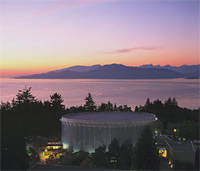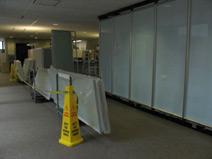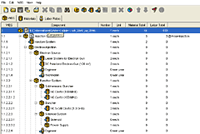 |
|
|
 |
Fermilab Cools First TESLA Cavity from DESY

Graduate student Tim Koeth (right) gives Barry Barish a tour of Capture Cavity II inside its cave in the ILCTA-MDB. |
On Monday, 6 February, a team of cryogenic engineers and accelerator physicists at Fermilab successfully cooled the first TESLA 9-cell 1.3 GHz cavity to 4.5 K (Kelvin) in the ILC Test Area in the Meson Detector Building (ILCTA-MDB). Travelling to Hamburg, Germany, Fermilab personnel assisted DESY in preparing the "ILC-like" cavity, called Capture Cavity II (CCII), and shipped it to its current home in Batavia, Illinois in August 2005.
"We cooled it down to verify the resonant frequency of the cavity and to test a piezo-electric 'fast' tuner. The cryogenic system worked flawlessly," said Fermilab's Tim Koeth, a graduate student at Rutgers University who is working on CCII as part of his thesis.
A 200 kW (kilowatt) klystron provides the RF (radiofrequency) power to the cavity, which currently lives in a "cave" for cryogenics testing in the ILCTA-MDB. Koeth and other members of the group will continue to test the CCII by measuring the Q (quality factor of resonance) measurement and peak accelerating field inside the cavity to make sure it performs as well here as it did at DESY. After testing is complete, CCII will move to the photoinjector. Inside the photoinjector, it will be put downstream of another superconducting cavity already in place to upgrade the energy from 15 MeV (million electron volts) to 40 MeV.
Read more...
-- Elizabeth Clements
|
 |
|
|
 |
|
 |
ALCPG and GDE Announce Vancouver Linear Collider Workshop, 19-23 July 2006

Chan Centre and Howe Sound at dusk - UBC Campus, north |
On behalf of the ALCPG and GDE, the Local Organising Committee of the Vancouver Linear Collider Workshop, invites you to the July 2006 joint meeting of the American Linear Collider Physics Group and the International Linear Collider Global Design Effort - organized by TRIUMF on the Campus of the University of British Columbia, Vancouver, Canada, Wednesday 19th to noon Sunday 23rd July.
The Vancouver ALCPG06 meeting is next in the continuing series of North American workshops on the physics, detector, and accelerator issues of the future International Linear Collider. The Vancouver GDE meeting will review progress with the ILC Reference Design Report (RDR) process. The meeting will open and close with joint plenary sessions, with parallel working sessions held between.
Read more...
-- VLCW06 Local Organising Committee |
 |
|
|
 |
From symmetry
February 2006, Issue 1, Vol. 3
Progress on the Linear Collider
During the year 2006, there will be many important developments in store for the proposed International Linear Collider. The Global Design Effort will undertake a new set of tasks and goals-primarily focused on producing a Reference Design Report, which will contain cost estimates for the ILC.
Read more...
From PPARC
13 February 2006
Einstein's theory 'improved'?
A Chinese astronomer from the University of St Andrews has fine-tuned
Einstein's groundbreaking theory of gravity, creating a 'simple' theory
which could solve a dark mystery that has baffled astrophysicists for
three-quarters of a century.
Read more...
From Chicago Sun-Times
10 February 2006
U.S. seeks bids on managing Fermilab, Argonne
...A European particle accelerator that is expected to begin running next year will be seven times more powerful than Fermilab.
After that, the next big thing will be the International Linear Collider, where subatomic particles will race down a straight 16-mile track and smash together...
Read more...
|
 |
|
|
 |
|

Get out your hardhats! The GDE office on the thirteenth floor of Fermilab's Wilson Hall is being built as we speak. Here you can get a view of the frosted windows outside the new GDE conference room.
|
|
 |
 |
|
|
 |
Work Breakdown Structure (WBS)

An example of a Work Breakdown Structure (WBS) |
The second meeting of the Reference Design Report (RDR) group leaders was held at Fermilab this past week. The primary purpose of this second RDR organizational meeting was to establish links between the RDR "Area Groups" and "Technical and "Global Groups", clarifying the work plan and methodology for obtaining the design and costs. The area groups are organized around accelerator subsystems (e.g. the main linac, positron source, etc), the technical groups cross subsystems (e.g. magnets, vacuum, cryogenics, etc) and the global groups cross subsystems and also have some elements outside subsystems (e.g. conventional facilities). Our plan is to do the design and costing of the ILC baseline by area (or subsystem) with the relevant costing inputs coming from the technical and global groups.
To organize the effort into a methodology that will capture all the costs for each subsystem, we will employ a "Work Breakdown Structure." At the Fermilab meeting, Peter Garbincius gave a talk entitled, "ILC Construction WBS," that described a draft WBS for the RDR that Wilhelm Bialowons developed.
Garbincius’ talk illustrates our transition from activities primarily focused on conceptual issues to ones more concerned with project issues. This change is necessary to enable us to specify the baseline ILC design details and costs. As a result, we are beginning to use standard project management techniques, and that includes using a Work Breakdown Structure (WBS).
So, what is a WBS and why do we use it? The concept underlying a WBS is not so foreign. Although we don’t use such terms, we naturally organize our lives using a work breakdown structure. If we need to get some task done, we often make a to-do list to organize our work, or even more informally in our everyday life we perform a set of tasks that enable us to do the activities of the day (we get up, have breakfast, drive to work, etc). In other words, we breakdown our day into small "work packages."
Read more...
--Barry Barish
Director's Corner Archive
|
 |
|
|
 |
|

